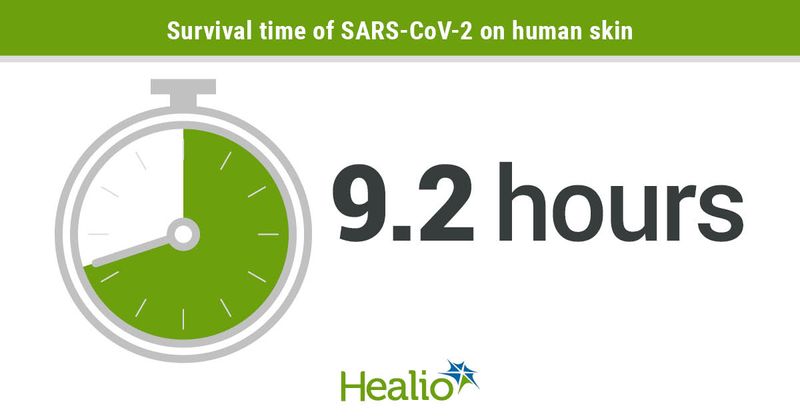SARS-CoV-2 survives for 9 hours on human skin
SARS-CoV-2 can survive on human skin for about 9 hours — significantly longer than influenza A virus — underscoring the importance of hand hygiene, researchers said.
Recent studies have looked at how long SARS-CoV-2 can survive on surfaces, with one analysis demonstrating that the virus was still viable for up to 28 days on glass, polymer currency, stainless steel, vinyl and paper currency.

However, the stability of SARS-CoV-2 and other highly pathogenic and infectious agents on human skin was unknown, according to Ryohei Hirose, of the department of infectious diseases at Kyoto Prefectural University of Medicine in Japan, and colleagues.
“It is critical to have information about the stability (survival time) of SARS-CoV-2 on the human skin to develop approaches to prevent contact transmission,” they wrote in Clinical Infectious Diseases.
Hirose and colleagues examined the stability of influenza A and SARS-CoV-2 mixed with mucus or a culture medium on “human skin obtained from forensic autopsy specimens.” They also tested the dermal disinfection effectiveness of 80% ethanol against each virus.
The survival time of SARS-CoV-2 (9.04 hours; 95% CI, 7.96-10.2) on skin was significantly longer than that of influenza A (1.82 hours; 95% CI, 1.65-2). Both viruses were completely inactivated following 15 seconds of ethanol exposure, and were inactivated more rapidly on skin than surfaces including glass, steel and plastic. On surfaces other than skin, the survival time was also longer for SARS-CoV-2 (11.09 hours; 95% CI, 10.22-12) than for influenza A (1.69 hours; 95% CI, 1.57-1.81).
“Appropriate hand hygiene using ethanol-based disinfectants leads to the quick viral inactivation and may reduce the high risk of contact infections,” the researchers wrote. “On the contrary, since not only the virus stability but also the infectious dose and transmission route may greatly affect the risk of contact transmission, future research needs to focus on factors other than virus stability.”

